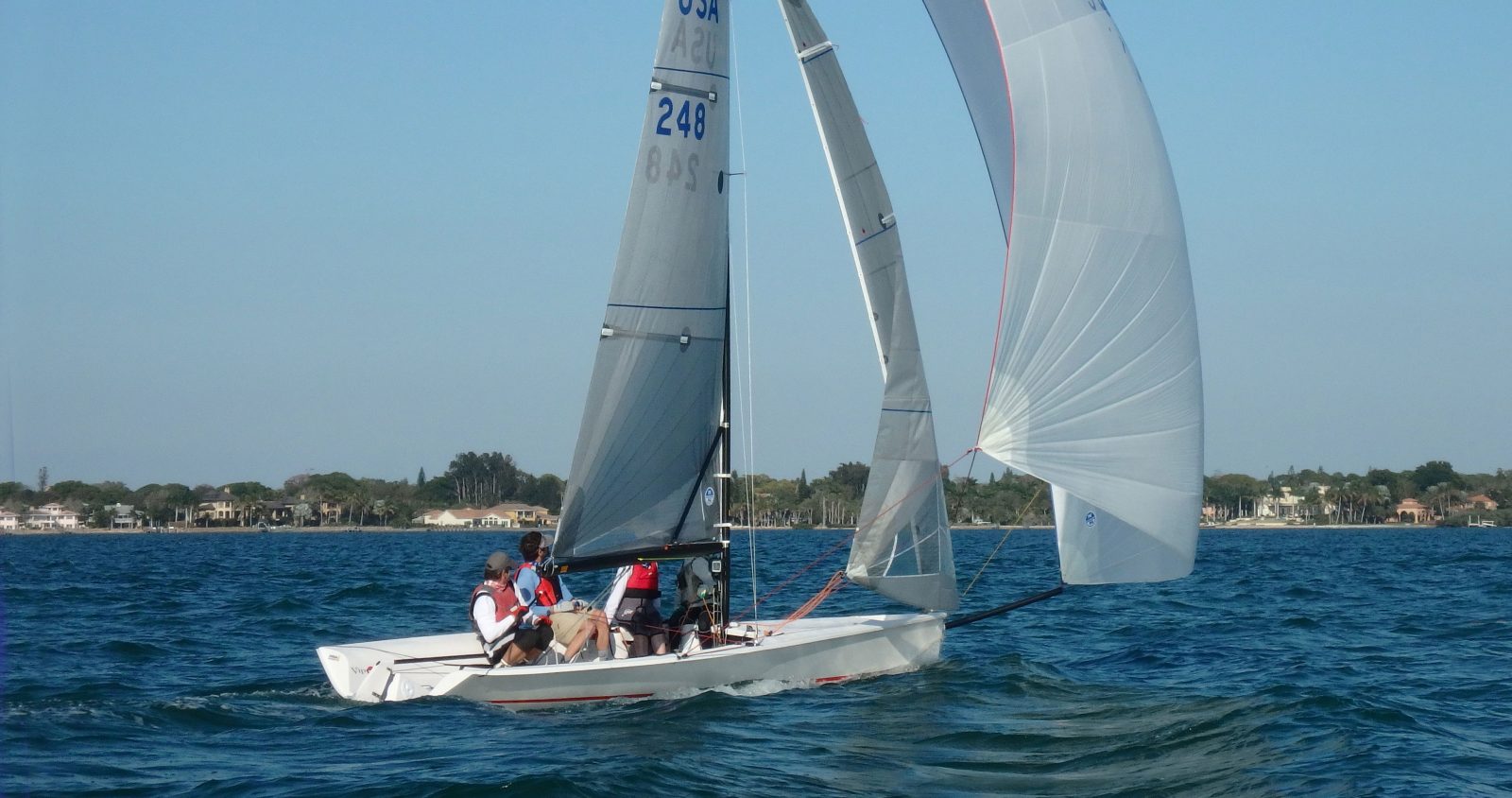GYBING LIKE A HERO
JIBING YOUR VIPER 640: HERO OR ZERO
Boat Handling Goes A Long Way
Whether you are gybing your Viper in 5 knots, 15 knots or 25 knots, A LOT can be gained or lost. Having the confidence that your crew can nail a stellar jibe at just the right moment in any condition is a truly liberating feeling that can see your team leaving other boats in the dust. No matter how much wind there is, the keys to a successful jibe are:
- Steering with your body weight
- Rate of tiller movement
- Getting the spinnaker filled on the new jibe
- Hitting the exit angle
CONVENTIONAL JIBE
If the wind is very light (under about 6 knots or so) you should try doing a “conventional jibe”. This method guarantees that the spinnaker is going to make it around the headstay (as long as everyone keeps their feet off the sheets!) which takes away the risk of messing up the “blow thru” part of the blow thru-jibe. There is nothing worse than having to pull the spinnaker off the windward side of the jib after failing to execute a blow-thru in light air. You’re dead in the water!
To execute the conventional jibe, the first thing to do is move body weight to weather to induce a down turn. The turn down can be slow so don’t move the tiller too much at first. The trimmer should slowly ease the sheet out as the boat turns down until they feel the pressure leave the sheet. This is usually right at about dead down wind with the clew of the kite eased to being nearly even with the head stay.
At this point, the trimmer drops the existing sheet and starts whaling on the new sheet, pulling it around as the helmsman speeds up the rate of turn, ultimately hitting the right exit angle, which needs to be high enough on the new jibe that the spinnaker is able to fill. This depends a lot on how light it really is. Whatever the crew can do to generate a bit of roll throughout this process is really helpful to keeping the speed up in the jibe.
Both the helmsman and the forward crew should stay on the old windward (or new leeward) side as long as it takes for the trimmer to fill the kite and get situated on the new board. There is always time to cross the boat!
BLOW-THRU JIBE
As soon as the wind is above 6 knots, we use the blow-thru method all the way up the wind range. To execute a good blow-thru, first be sure that both sheets are ready to run clean. Just like in light air, it is important to try to steer the boat with body weight, so have all the crew lean to weather to start the jibe.
As the boat begins to turn down, the trimmer should give 1-3 good pumps of the existing sheet (depending on how long their arms are!) which flattens out the spinnaker and makes it easier for the breeze to now fill it on the new side. The jib trimmer can also trim the existing sheet in at this time.
It’s very important that, after the initial down turn using body weight, the helmsman really tugs the tiller and turns sharply. The forward crew should have to hang on tight so they don’t get ejected! A good blow-thru means that the kite goes from full one side to full on the other side as quickly as possible. Doing a fast turn enables a quick transition for the kite so practice over-exaggerated turns and then start to slow yourself down if you are too quick (I bet you won’t be!).
As we are passing dead down wind and the spinnaker has lost all its pressure (and while the helm is still hard over) we recommend having the forward crew reach up to the spinnaker clew and give it a nice yank down and back. This puts tension on the leech and flattens the sail, making it much easier to fill onto the backwinded jib. A critical part of the sail actually blowing around the headstay is that it actually fills from the leech first. This little yank makes this much for likely to happen.
At about the same time the forward crew does the yank, the trimmer should now be over to the new sheet which should only require a few big pulls since the wind is now doing most of the work for you. This is the time when it is really important that the helmsman finds the right exit angle. As soon as they see that they’ve turned fast enough to execute the blow-thru, they can slow the turn down a bit and start to try to feel the boat based on its heel angle. If the boat is dead flat, you need to keep turning up to the appropriate exit angle. If you feel you’re starting to wipe out….. Time to ease the sheets, get to the high side and try to turn back down a bit! (scooting aft in the boat can help avoid a wipe out too)
After the kite is all the way around the head stay and filling on the new side, the jib trimmer can go ahead and switch the jib as well. The method of this jibe really doesn’t change much in the different wind speeds – you just need to practice a lot in all conditions to hone in on the variables like rate of turn, exit angle, and how much sheet you need to go through.
HEAVY AIR
If you are starting to get towards “survival conditions” for your team, you can reintroduce the “conventional jibe” again. It may be a little less risky in terms of wiping out. The key here is to try to find a good wave to surf down as you begin the jibe so that the load on the sails decreases. As you are surfing down the wave, you can ease the kite out a few feet, get to dead down wind and then flick the main over and cross the boat. Once the main and the crew have switched sides, the boat becomes a lot more stable. Then the trimmer can pull (hard!) on the new sheet to start to pull it around as the helmsman conservatively turns up to find the angle where the kite will fill again. This method won’t be quite as fast as a perfectly nailed blow-thru jibe in 25 knots, but it is a heck of a lot faster than turning over from messing one up!



























